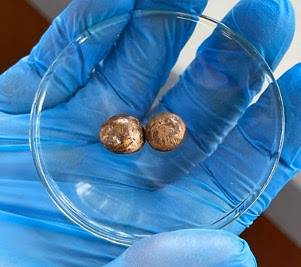Libero Copper & Gold Corporation (TSXV:LBC) together with the National University of Colombia (UNAL), has extracted metallic copper from pulp from the Mocoa copper-molybdenum deposit in Colombia.
It is the first copper produced in Colombia from a deposit in Colombia. Pulps from Mocoa were taken to the Mineral Institute CIMEX of UNAL, where a concentrate of copper minerals was produced, and then metallic copper was extracted.
The project was executed under the framework agreement between Libero Copper and UNAL.
“Colombia is moving away from oil, gas and coal, industries that represent half of the country’s exports, towards a green economy, away from extraction to a model of production, with transition metals at the base,” , President and CEO, Ian Harris, said.
“Copper is the core to capture, store and transmit these new sources of energy. This milestone of the first copper production in Colombia is a testament to our shared commitment to creating a fully vertically integrated, clean energy system and a renewed focus on innovation and job creation within Colombia.
“Mocoa is the largest copper resource in Colombia and critical to positioning Colombia as an international leader in clean energy production. We are working with the government to create a roadmap for Mocoa through copper production, with emphasis on the inclusion of national universities and our communities.”
The energy transition and the potential of copper in Colombia has been a significant part of the national conversation. Libero Copper has held multiple interviews nationally, including in prime-time news and the largest printed press in the country, and continues to provide leadership as a founding member of the Copper Mining Hub.
In addition, Libero Copper has held multiple meetings with government officials to help develop a shared vision on the strategic planning of Colombia focused on energy transition and the industrial shift to production chains based on strategic metals that are inclusive, participatory, and knowledge intensive.
Meetings have included the Vice-Minister of Mines, Giovanni Franco; the Minister of Industry, Commerce and Tourism, German Umaña; senior advisors to the President of Colombia, and the National Geological Service. Mr Franco is a PhD mining and a metallurgical engineer, and professor at UNAL. Mr. Umaña has been an economics professor at UNAL since 1980, including times as Vice Director and Dean of the economics department.
The National University of Colombia, founded in 1867, has been at the forefront of academic study and research for more than one a half-century. It’s the leading university in Colombia and one of the most representative in Latin America. The Mines Department was founded in 1886 at the Medellin campus.
About the Mocoa Porphyry Copper-Molybdenum Deposit
The Mocoa deposit is located in the department of Putumayo, 10 kilometres from the town of Mocoa. Libero Copper’s district scale holdings cover over 1,000 sq. km encompassing most of the Jurassic porphyry belt in southern Colombia.
Mocoa was discovered in 1973 when the United Nations and the Colombian government conducted a regional stream sediment geochemical survey. Between 1978 and 1983, an exploration program was carried out that consisted of geological mapping, surface sampling, ground geophysics (IP, magnetics), 31 diamond drill holes totalling 18,321 m and metallurgical test work cumulating in a positive pre-feasibility study (the pre-feasibility study is historical in nature only and should not be relied upon as it is not NI 43-101 compliant). B2Gold subsequently executed diamond drill programs in 2008 and 2012. Libero Copper commenced drilling in March 2022 with the first hole returning 840 m of 0.72% copper equivalent.
A pit constrained inferred resource at Mocoa contains 636 million tonnes of 0.45% copper equivalent (0.33% Cu and 0.036% Mo) generated using $3/lb Cu and $10/lb Mo, containing 4.6 billion pounds of copper and 511 million pounds of molybdenum. The Mocoa deposit appears to be open in both directions along strike and at depth. Current work on the property has identified additional porphyry targets including the possible expansion of known mineralization.
The Mocoa deposit is situated in the Eastern Cordillera of Colombia, a 30-km-wide tectonic belt underlain by volcano-sedimentary, sedimentary and intrusive rocks that range in age from Triassic-Jurassic to Quaternary and by remnants of Paleozoic metasediments and metamorphic rocks of Precambrian age.
This belt hosts several other porphyry-copper deposits in Ecuador, such as Mirador (438 million tonnes measured and indicated at 0.61% Cu and 235 million tonnes inferred at 0.52% Cu)2, San Carlos (600 million tonnes inferred at 0.59% Cu)3, Panantza (463 million tonnes inferred at 0.66% Cu)4 and Solaris’ Waritza, located in Ecuador.
Copper-molybdenum mineralization is associated with dacite porphyry intrusions of the Middle Jurassic age that are emplaced into andesitic and dacitic volcanics. The Mocoa porphyry system exhibits a classical zonal pattern of hydrothermal alteration and mineralization, with a deeper central core of potassic alteration overlain by sericitization and surrounded by propylitization.
Mineralization consists of disseminated chalcopyrite, molybdenite and local bornite and chalcocite associated with multiphase veins, stockwork and hydrothermal breccias. The Mocoa deposit is roughly cylindrical, with a 600 metre diametre. High-grade copper-molybdenum mineralization continues to depths in excess of 1,000 metres.
For further information please visit: https://www.liberocopper.com/












